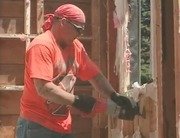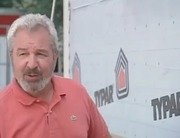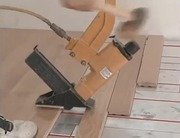One hour north of New York City, in Westchester County, architect Mary Kennedy and her husband, Bobby, son of the late senator Robert F. Kennedy, are nearly finished with their green project.
They've come a long way from the day they discovered that a flood had ruined their home.
"We walked into the house, and were absolutely in a state of shock.
I found a foot of standing water in the basement, and I found mold throughout the house, from the basement through the third floor, through the attic."
Mary, you have had a huge job here, because part of that job was breaking the news to your family that the house had become a sick house, and was beyond repair, couldn't be salvaged.
Isn't that right?
"That''s right.
And it was really devastating to Bobby and to the children, and in order to walk them through that process What we decided to do was, rather than simply simply demolish the building, to go through a process of salvage.
And then, deconstructing the house bit by bit, with the intention of saving absolutely everything that was not mold contaminated.
And we actually couldn't really embark on the design process until all of that was done."
Until you could figure out what materials you'd be able to re-use.
"That's right."
The Kennedy's wanted to preserve the spirit of their old house, but they also saw the project as an opportunity, even an ob ligation, to incorporate green technologies into their new house.
So, from the building green perspective, let's talk about the windows and doors.
Obviously, you couldn't salvage the old ones, which were totally inefficient.
"The old ones were a single pane glass.
They were leaky, they were really not functioning terribly well.
And I think that this was probably the biggest, and it is the biggest single ticket item in the construction, but, and it is for most homeowners.
But there have been so many incredible advances in terms of energy efficiency with windows and doors.
Right, the glass technology available in windows and doors today just didn't exist a decade ago.
Exactly.
Mary, we're up here on the roof, and I'm glad that you designed this place so there's a flat portion cause these are pretty steep angles, steep pitches.
But, all of the slate is salvaged, right?
The slate is all salvaged from the same place that we brought the brick and the interior doors from.
From the institution s in upstate New York that were being demolished.
Yeah, these slates were probably specified 100 years ago for these institutional buildings.
Right.
Which were meant to last for centuries.
Absolutely.
Let's talk about the other slope of the roof behind us here, because this is a high tech green roofing product.
You go from something very old to something super new.
These are actually the latest generation of these solar slates.
They're going to be generating electricity for your house.
They will generate electricity and in fact this array should exceed the needs of the house.
So, we'll be able to sell energy back to the energy company.
Mary the flat portion of the roof is not visible from the ground, but you do have a lot of unusual machine for living kind of stuff up here.
What are these?
One of the, I think, really, the most remarkable and wonderful features of that, that we've been able to employ are these solar-tubes.
What they do is they bring natural daylight into interior spaces.
So it isn't just a skylight, there's a tube attached to it
There is a mylar tube that goes down and so every single closest, hallway, any place where we don't have a window.
We actually have been able to bring daylight into those spaces.
So you can avoid.
using electrical lighting in back halls and side closets and all these areas.
I think it's something that everybody should consider doing because there will be just enormous savings.
Yeah, there's so many different little things that when you put them all together they add up to a lot.
Yep, absolutely.
Right.
Well, Mary, it's an exciting project, and I think you're really succeeding at blending all these green technologies and green concepts with this love story and you've got with the house of replicating what you lost in bringing in all these other elements.
What happens here?
This is the new version of the old portico vestibule.
It is.
What we, this vestibule, actually had been here and we have referenced it.
It's not exactly as it was, and then of course there will be another door here.
So for energy conservation.
You have an airlock.
You have an airlock.
And what are the flip finishes going to be?
And what we have decided to do, is to use river rocks as After field, and we have collections.
Many, many collections of rocks from everywhere.
So this will be the floor?
So that will be the field.
Then , there will be a border of fossils.
We have forty some odd boxes to chose from.
So that will be a small border around the perimeter, and hopefully it will be a good reminder to the children of their contribution to the house.
Excellent.
Well it's a beautiful job and I hope we get to see the finished product.
Well thank you.
Thanks for the tour.
You're always invited.
Bob Vila building green.
We'll take you to some of the most exciting green projects in the country, and I'll introduce you to fascinating people who will challenge your notions of how homes should be built.




